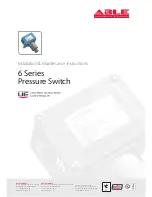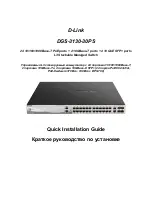
FLUID COMPONENTS INTERNATIONAL LLC
FLT93 Flow Switch Series
This page is subject to proprietary rights statement on last page
10
Doc. No. 06EN003312 Rev. D
11. Determine the set point by calculating the average of the wet and dry output signals. (i.e., If the wet signal is 0.200
volts and the dry signal is 4.000 volts, then the calculated set point would be 2.100 volts.)
12. Record this value.
Calculated Set Point = ________ volts DC
Note:
The calculated set point must be at least 0.015 volts greater than the wet signal and 0.020 volts less than the
dry signal to ensure that the alarm will reset.
13. Slide the mode switch to the CALIBRATE position.
14. Adjust the calibrate potentiometer (R24) until the voltmeter equals the calculated set point.
15. For the appropriate alarm, determine whether the status LED is on or off (red for No. 1 or green for No. 2).
16. Follow either the Detecting Dry Condition or the Detecting Wet Condition for each level application alarm.
Detecting Dry Condition (low level alarm)
If the status LED is off, turn the set point adjustment potentiometer (R26 for alarm No. 1 or R25 for alarm
No. 2) slowly clockwise just until the LED turns on.
OR
If the status LED is on, turn the set point adjustment potentiometer (R26 for alarm No. 1 or R25 for alarm No. 2)
counterclockwise until the LED turns off and then slowly clockwise just until the LED turns on.
Detecting Wet Condition (high level alarm)
If the status LED is on, turn the set point adjustment potentiometer (R26 for alarm No. 1 or R25 for alarm No. 2)
slowly counterclockwise just until the LED turns off.
OR
If the status LED is off, turn the set point adjustment potentiometer (R26 for alarm No. 1 or R25 for alarm
No. 2) clockwise until the LED turns on and then slowly counterclockwise just until the LED turns off.
17. Slide the mode switch to the RUN position. The status LED should be on if the sensing element is dry and off if the
sensing element is wet.
18. Monitor the voltmeter display while raising or lowering the process fluid level. When the output signal passes
through the set point, the status LED should change states and the relay contacts should change state.
19. Reestablish the normal level condition. Both the LED and relay contacts should reset.
20. Disconnect the voltmeter from P1.
21. Replace the enclosure cover.
Note:
The relay logic default configuration is set for the relay coil to be de-energized when the level signal is
greater than the set point value. (i.e., The relay coil will be de-energized when the sensing element is dry.)
A recommendation is to have the relay coils energized when the process condition is normal. This will
enable the alarm to close or open the contacts in case of a power failure.
Temperature Applications
If the adjustment by observation is not accurate enough for the application, adjustment with a voltmeter can be
accomplished using manual 06EN003246. See the Operation Section of the manual for complete instructions.






























